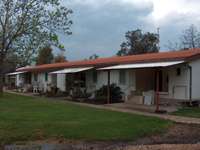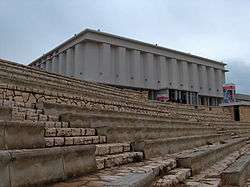Lohamei HaGeta'ot
| Lohamei HaGeta'ot לוֹחֲמֵי הַגֵּטָאוֹת | |
|---|---|
 | |
 Lohamei HaGeta'ot | |
| Coordinates: 32°57′45.71″N 35°5′44.52″E / 32.9626972°N 35.0957000°ECoordinates: 32°57′45.71″N 35°5′44.52″E / 32.9626972°N 35.0957000°E | |
| District | Northern |
| Council | Mateh Asher |
| Affiliation | Kibbutz Movement |
| Founded | 1949 |
| Founded by | Surviving fighters of the Warsaw Ghetto Uprising, former Jewish partisans and other Holocaust survivors. |
| Population (2017)[1] | 661 |
| Name meaning | The fighters of the ghettos |
Lohamei HaGeta'ot (Hebrew: לוֹחֲמֵי הַגֵּיטָאוֹת, lit. The Ghetto Fighters) is a kibbutz in northern Israel. Located in the western Galilee, it falls under the jurisdiction of Mateh Asher Regional Council. In 2017 it had a population of 661.[1]
History
The kibbutz was founded in 1949 on the coastal highway between Acre and Nahariya, on the site of abandoned British Army base[2] and depopulated Palestinian village of al-Sumayriyya.[3] Its founding members include surviving fighters of the Warsaw Ghetto Uprising (notably Icchak Cukierman, ŻOB deputy commander), as well as former Jewish partisans and other Holocaust survivors. Its name commemorates the Jews who fought the Nazis.[4]
Economy
In the mid-1980s the kibbutz acquired the Tivall vegetarian food products factory, which has become a mainstay of its income. Other branches include a large dairy and agriculture and a bed and breakfast. The kibbutz is currently undergoing a process of privatization. It operates a bed and breakfast for tourists to the area.
Archaeology
Alongside the kibbutz are the extensive remains of an aqueduct which supplied water to Acre some 6 km away, until 1948. The aqueduct was originally built at the end of the 18th century by Jezzar Pasha, the Ottoman ruler of Acre, but was completely rebuilt by his successor, Suleiman, in 1814.[5]
Museum
The kibbutz operates the Ghetto Fighters' House, a history museum commemorating those who fought the Nazis. Adjacent to the museum is a large amphitheater used frequently for concerts, assemblies, and ceremonies hosted by the museum.

Notable residents
References
- 1 2 "List of localities, in Alphabetical order" (PDF). Israel Central Bureau of Statistics. Retrieved August 26, 2018.
- ↑ "יום מרד הגיטו בקיבוץ ע"י לוחמיו" (in Hebrew). Retrieved 2017-10-15.
- ↑ Khalidi, Walid (1992). All That Remains: The Palestinian Villages Occupied and Depopulated by Israel in 1948. Washington D.C.: Institute for Palestine Studies. pp. 30–31. ISBN 0-88728-224-5.
- ↑ http://www.gfh.org.il/eng/?CategoryID=231
- ↑ Moreh Derech trip report
Bibliography
External links
| Wikimedia Commons has media related to Lohamei HaGeta'ot. |